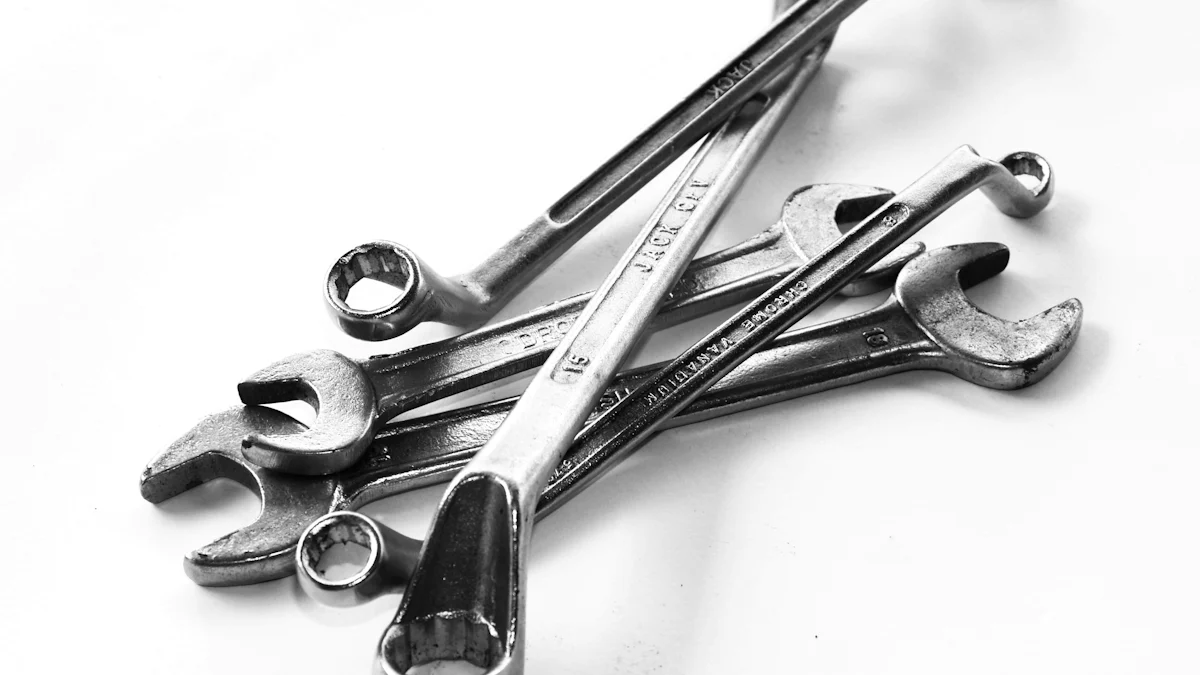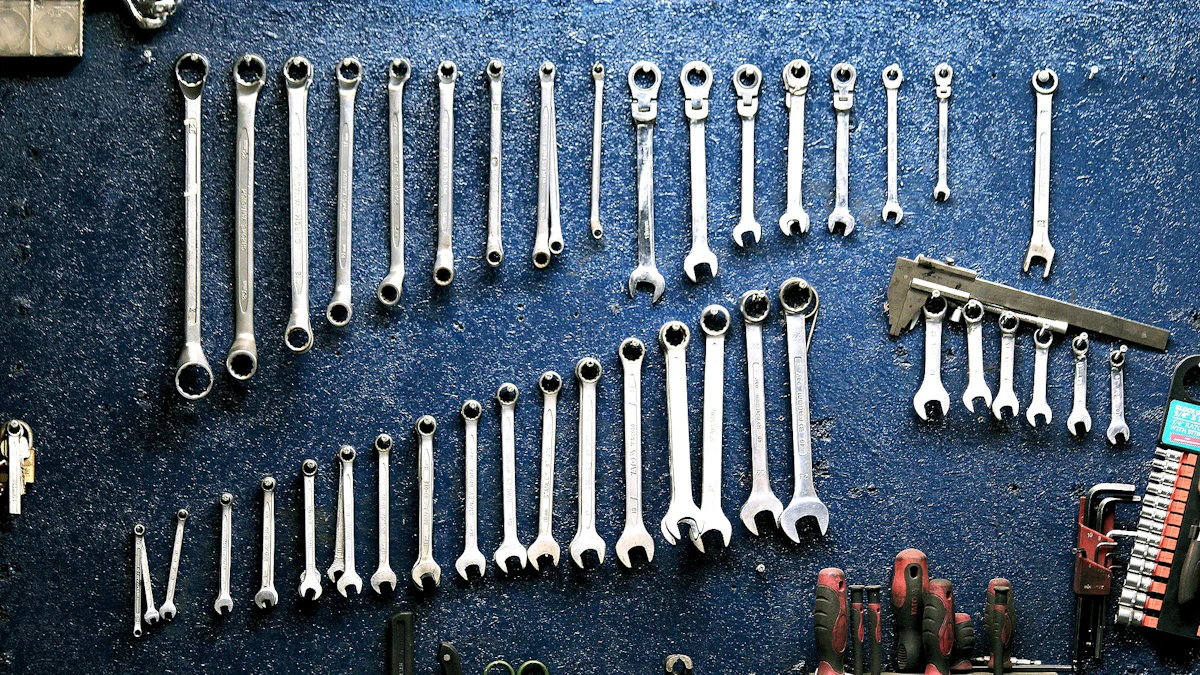
A spanner serves as a vital tool in many industries. You will often find spanners in automotive repair, manufacturing, and construction. These tools help you apply torque to fasteners like nuts and bolts. The design of a spanner ensures a firm grip, which minimizes equipment downtime and prevents premature wear. Spanners come in various forms, each tailored for specific tasks. Understanding how to define spanner will enhance your ability to choose the right tool for any job.
Define Spanner: Spanners vs. Wrenches
Define Spanner: Terminological Differences
British English vs. American English
The term “spanner” often causes confusion due to differences in British and American English. In British English, people commonly use “spanner” to refer to a tool that grips and turns fasteners. Americans, however, use the term “wrench” more frequently. This distinction can lead to misunderstandings when discussing tools across these regions. The origin of the term “spanner” traces back to Europe, where it described a tool for turning objects. Americans adopted the term “wrench” for similar tools.
Common Misunderstandings
Misunderstandings often arise from these terminological differences. In American English, a spanner refers to a specialized wrench with pins or tabs. This differs from the British usage, where “spanner” serves as the standard term for such tools. Many people mistakenly believe these terms are interchangeable. However, each term has specific meanings in different contexts. Understanding these differences helps avoid confusion when selecting tools for various tasks.
Functional Differences
Usage Scenarios
Spanners and wrenches serve different purposes based on their design. A spanner provides precision and control, making it ideal for mechanical and engineering settings. People often use spanners for tasks requiring a firm grip on fasteners. Wrenches, on the other hand, offer versatility due to their adjustable jaws. This feature allows them to fit various sizes of fasteners. Each tool excels in specific scenarios, highlighting the importance of choosing the right one.
Design Variations
Design variations further distinguish spanners from wrenches. Spanners typically have a fixed size, which ensures a snug fit on specific fasteners. This design minimizes the risk of slipping during use. Wrenches, with their adjustable jaws, adapt to different fastener sizes. This flexibility makes wrenches suitable for a wide range of applications. Understanding these design differences aids in selecting the appropriate tool for any job.
Types of Spanners

Open-Ended Spanners
Specific Uses
Open-ended spanners feature two U-shaped openings at each end. These openings fit over fasteners like nuts and bolts. Mechanics often use open-ended spanners in automotive repair. The design allows for quick adjustments without removing the tool from the fastener. Open-ended spanners work well in tight spaces where other tools might not fit.
Advantages
The main advantage of open-ended spanners is accessibility. The open ends allow users to slide the spanner onto a fastener from the side. This feature saves time during repetitive tasks. Open-ended spanners also offer versatility. Users can choose from different sizes to match specific fasteners. The simple design makes these spanners easy to use, even for beginners.
Adjustable Spanners
Specific Uses
Adjustable Spanners have a movable jaw. This feature allows users to adjust the spanner to fit various fastener sizes. Plumbers and maintenance workers often use adjustable spanners. The tool adapts to different fasteners, making it ideal for general repairs. Users find adjustable spanners particularly useful when working with fasteners of varying sizes.
Advantages
The key advantage of adjustable spanners is flexibility. One tool can handle multiple fastener sizes. This reduces the need for carrying multiple spanners. Adjustable spanners also save space in toolboxes. The movable jaw provides a secure grip on fasteners. This reduces the risk of slipping and damaging the fastener. The versatility of adjustable spanners makes them a valuable addition to any toolkit.
Ring Spanners
Specific Uses
Ring spanners have a closed loop at one or both ends. This loop fits snugly around fasteners. Users often employ ring spanners in situations requiring high torque. The design ensures a firm grip, reducing the chance of rounding off fasteners. Ring spanners excel in tasks involving heavy machinery and equipment.
Advantages
The closed-loop design of ring spanners offers several advantages. The full contact with the fastener provides maximum torque. This feature makes ring spanners ideal for loosening stubborn fasteners. The design also minimizes the risk of slippage. Users benefit from increased safety and efficiency. Ring spanners provide durability, making them a long-lasting tool choice.
Design Features of Spanners

Holes and Projections
How They Engage with Fasteners
Spanners often feature holes and projections. These elements play a crucial role in how spanners engage with fasteners. Holes in a spanner allow for a secure fit over the fastener. This design ensures that the spanner grips the fastener tightly. Projections on a spanner can align with specific notches or slots on a fastener. This alignment provides additional stability during use. The combination of holes and projections enhances the tool’s ability to apply torque effectively.
Benefits of These Features
The benefits of holes and projections in spanners are significant. These features provide a more reliable grip on fasteners. A secure grip reduces the risk of slipping, which can cause damage to both the tool and the fastener. The precise engagement also allows for greater control when tightening or loosening fasteners. This control minimizes the chance of rounding off fastener edges. The design features contribute to the overall efficiency and safety of using a spanner.
Hooks and Other Features
How They Engage with Fasteners
Hooks and other unique features distinguish certain spanners. Hooks on a spanner can latch onto corresponding parts of a fastener. This latching mechanism provides a firm hold. Other features, like specialized grooves or teeth, enhance the spanner’s grip. These elements ensure that the spanner remains in place during use. The design of hooks and additional features focuses on maximizing contact with the fastener.
Benefits of These Features
Hooks and other features offer several advantages. The primary benefit is increased stability. A stable connection between the spanner and the fastener reduces the likelihood of slippage. This stability translates to more efficient work. Users can apply force with confidence, knowing the spanner will hold. The enhanced grip also protects the fastener from wear and tear. These design elements make spanners versatile tools for various applications.
Practical Tips
Choosing the Right Spanner
Factors to Consider
Selecting the right spanner involves several key factors. First, assess the size of the fastener. A spanner must fit snugly to ensure effective torque application. Material quality also plays a crucial role. High-quality materials provide durability and reliability. Consider the specific task requirements. Different tasks may demand different spanner types. Evaluate the comfort and grip of the spanner handle. A comfortable grip enhances control and reduces fatigue during use.
Common Mistakes to Avoid
Avoid common mistakes when choosing a spanner. Do not select a spanner based solely on price. Low-cost options may compromise quality and performance. Ensure the spanner fits the fastener properly. An improper fit can lead to slipping and damage. Avoid using a spanner for tasks it is not designed for. Misuse can result in tool breakage or injury. Always check the condition of the spanner before use. Damaged tools can pose safety risks.
Maintenance Advice
Cleaning and Storage
Proper cleaning and storage extend the life of your spanners. After each use, clean the spanner with a damp cloth. Remove any dirt or grease that may have accumulated. Dry the spanner thoroughly to prevent rust formation. Store spanners in a dry, organized toolbox. Proper storage prevents damage and makes tools easy to locate. Regularly inspect spanners for signs of wear or damage.
Ensuring Longevity
Ensuring the longevity of spanners requires consistent care. Lubricate moving parts of adjustable spanners periodically. Lubrication maintains smooth operation and prevents rust. Avoid exposing spanners to extreme temperatures. Extreme conditions can weaken the material and reduce lifespan. Handle spanners with care to avoid dropping or bending them. Proper handling preserves the integrity of the tool. By following these maintenance tips, you can enjoy reliable and long-lasting spanners.
Understanding the design and function of spanners enhances your ability to select the right tool. Each spanner type serves a specific purpose. Proper selection ensures efficiency and safety in tasks. Knowledge of when to replace spanners maintains safety standards. Applying this knowledge in practical scenarios improves task outcomes. Choosing the correct tool impacts the success of your projects. Always prioritize the right tool for the job.
